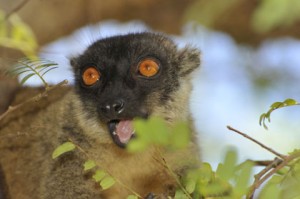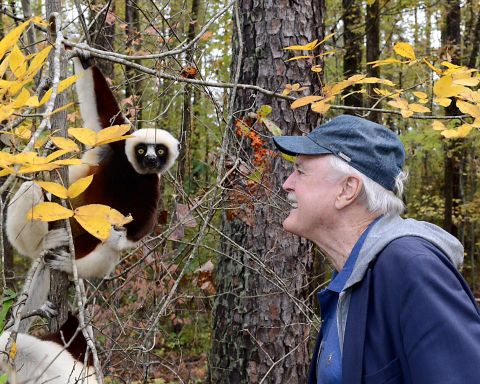December 31, 2015 — Today is the last day of 2015. The end of the year always prompts us to look back over the last 12 months and reflect on new achievements in research and conservation. This past year, lemur science and Madagascar conservation reached new heights of awareness. We learned about climate change and hibernation, welcomed new lemurs to the Center, and said goodbye to dear friends. We went through and found 5 of the top lemur-related stories from 2015 to bring to you today.
Climate Change will take lemurs’ land

Common brown lemurs are expected to lose half of their habitat before century’s end due to climate change. Photo by David Haring.
Scientist Jason Brown at the City University of New York and Anne Yoder, DLC Director, modeled habitat changes in Madagascar as the planet continues to warm. Greenhouse gas emissions building up in the atmosphere lead to a rise in global temperatures and changes in climate patterns in places like Madagascar. The result is that habitat for lemurs in Madagascar will change dramatically, causing lemurs to seek refuge to find enough food or deal with new climate patterns like less rainfall. Brown and Yoder studied 57 lemur species and found that 60% of them will lose land as the planet warms. Only 9 species included in the study will see an increase in range size. To help lemurs, researchers pinpointed key areas for conservation (one of these was the SAVA region where the DLC works) that would preserve future ranges for lemurs, and they located corridors that would facilitate the gradual transition as lemur ranges shifted. Conservationists planning for the future will need to include climate change in long term planning to accommodate where lemurs may not be now but may move in the future.
Live Long and Hibernate

Jonas lived to be 29.5 years old, a record for such a small lemur. Hibernating may have played a key role in his longevity. Photo by David Haring.
Jonas was the oldest fat-tailed dwarf lemur known to science. He passed away this year at the old age of 29.5, an impressive life span for a primate 6 inches tall and weighing a half-pound. Researchers Sarah Zehr and Marina Blanco with the DLC discovered that dwarf lemurs live two to three times longer than similarly sized mammals. The reason they live so long could be in their natural ability to hibernate. Dwarf lemurs will hibernate for up to, and sometimes over, half the year. Their heart nearly stops beating, their breathing slows and internal boy temperature will match ambient temperatures. The longer life could come from avoiding predators for so many months of the year, or the reason could be that cells don’t build up as much damage because they’re not working as hard for much of the year. The research could even help scientists uncover secrets to ageing in humans.
Girls Rule, Boys Drool

This male crowned lemur (left) hopes for a bite of honeysuckle that the female (right) isn’t likely to share. Photo by David Haring.
Lemur females rule the forest in Madagascar. Within lemur social groups, females receive first access to food, they choose their mates, and females generally get whatever they want – sometimes by force. Females are no bigger or stronger than males, so how they get to be in charge? Joseph Petty, Ph.D. and Christine Drea, Ph.D. at Duke studied females at the DLC who loved in female dominant groups and co-dominant groups (male and females on roughly equal footing). They discovered that those females who were more dominant had higher levels of testosterone than those females who were not dominant. Dominant females get a boost from male hormones, and they may be more sensitive to its effects making them more aggressive.
King Julien names two baby lemurs
The Duke Lemur Center teamed up with King Julien to welcome two new baby lemurs to the world! Meet Princess Julien and Princess Julien, both named after his royal majesty King Julien XIII, star of the hit new series All Hail King Julien on Netflix.
Visits from special guests!
 The Duke Lemur Center welcomed several amazing guests this year: singer/songwriter Sarah McLachlan, comedian John Cleese, and neurologist Dr. Oliver Sacks. McLachlan visited the Lemur Center with family when her tour stopped for a performance at the Durham Performing Arts Center. After a wonderful tour behind the scenes, she even promoted the DLC during an audience Q&A during her performance! Comedian John Cleese is actually a huge lemur fan, too! In 1997, he worked with DLC staff during the black-and-white ruffed lemur captive to wild re-introduction project and made a documentary about it. In fact, it was his favorite project ever to work on! He visited the DLC recently and had such a wonderful time that he told everyone about his visit in his comedy show that night! We were also fortunate to welcome the esteemed neurologist Dr. Oliver Sacks this year. He included his visit to the DLC as a highlight in a New York Times op-ed. We also grieved with many around the world when we learned the news of his passing, and were so grateful for the opportunity to share our work with him and his partner Billy Hayes.
The Duke Lemur Center welcomed several amazing guests this year: singer/songwriter Sarah McLachlan, comedian John Cleese, and neurologist Dr. Oliver Sacks. McLachlan visited the Lemur Center with family when her tour stopped for a performance at the Durham Performing Arts Center. After a wonderful tour behind the scenes, she even promoted the DLC during an audience Q&A during her performance! Comedian John Cleese is actually a huge lemur fan, too! In 1997, he worked with DLC staff during the black-and-white ruffed lemur captive to wild re-introduction project and made a documentary about it. In fact, it was his favorite project ever to work on! He visited the DLC recently and had such a wonderful time that he told everyone about his visit in his comedy show that night! We were also fortunate to welcome the esteemed neurologist Dr. Oliver Sacks this year. He included his visit to the DLC as a highlight in a New York Times op-ed. We also grieved with many around the world when we learned the news of his passing, and were so grateful for the opportunity to share our work with him and his partner Billy Hayes.
Thank you for your support!
The work of the Duke Lemur Center could not be possible without our lemur-loving, science-enthused, conservation-caring community of support. You give us your time, effort and financial support, and we could not be more grateful. If yo uwish to make a year-end gift, just click here to go straight to the donation page. Donations made before midnight, 12/31/15, count toward 2015 tax deductions.
From all of us at the Duke Lemur Center, Happy New Year!


